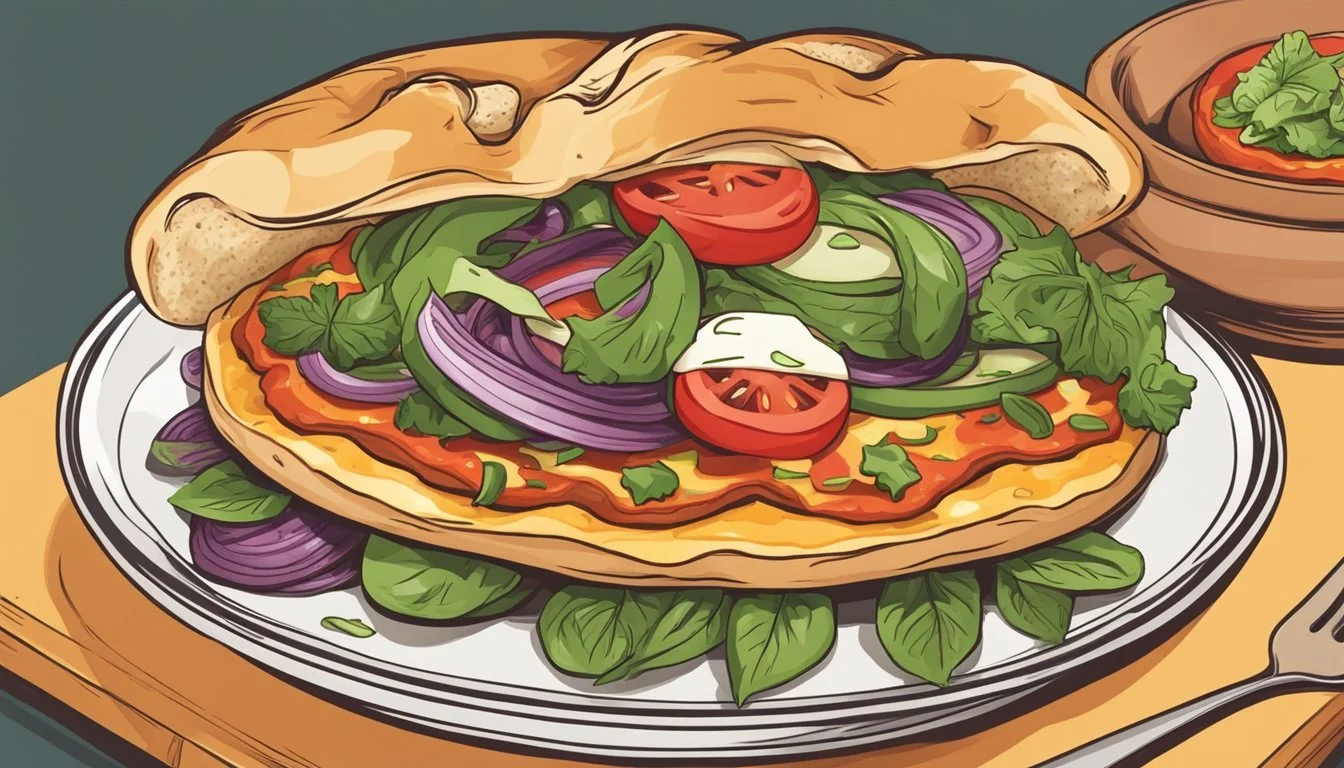Is Pizza Bagel Vegan?
Uncovering the Ingredients
The classic pizza (What wine goes well with pizza?) bagel, a delicious fusion where Italian cuisine meets the quintessential American breakfast staple, faces scrutiny through the lens of veganism. For those adhering to a plant-based diet, the question of whether pizza bagels can fit into their dietary choices is of significant interest. Traditionally, pizza bagels are not vegan, as they typically include cheese, which is a dairy product, and they may also feature toppings such as pepperoni or sausage, both of which are meat-based. However, the ever-growing demand for vegan options has inspired a myriad of plant-based alternatives that cater to these dietary restrictions.
In the landscape of vegan pizza bagels, innovations in dairy substitutes have produced a wide variety of non-dairy cheeses made from nuts, soy, and other plant sources. These alternatives purposefully attempt to replicate the taste and melting properties of traditional cheese, which is a critical component of a satisfying pizza bagel experience. Moreover, an assortment of plant-based meats now offers the flavors and textures reminiscent of conventional pizza toppings (What wine goes well with pizza toppings?) without any animal-derived ingredients. This advancement allows for the recreation of beloved pizza bagel varieties that are entirely vegan.
Vegan pizza bagels have, thus, become a welcome addition to both commercial establishments and home kitchens. They offer a plant-based rendition of the classic savory snack, wherein every component from the bagel base to the toppings and cheese can adhere to vegan standards. This aligns with a growing trend of inclusive culinary practices that aim to respect diverse dietary choices while still delivering the comfort and familiarity of well-loved dishes.
Understanding Veganism
Veganism is more than a diet; it's a lifestyle choice that abstains from all animal products and by-products. This section explores the definition of veganism, the benefits associated with a vegan diet, and the common substitutes that allow vegans to enjoy a wide variety of foods, including pizza bagels.
Defining Vegan
A vegan diet excludes all forms of animal exploitation and cruelty, from food to clothing and any other purposes. Nutritionally, it focuses on plant-based foods and eliminates all animal-derived ingredients.
Protein: Vegans obtain protein from plant sources such as legumes, nuts, seeds, and whole grains.
Fats: Healthy fats are sourced from avocados, nuts, and seeds.
Fiber: A vegan diet is typically high in fiber from fruits, vegetables, legumes, and whole grains.
Vital vitamins and minerals like Vitamin A, Vitamin C, Calcium, Potassium, and Iron come from a diverse range of fruits, vegetables, fortified foods, and supplements.
Benefits of Vegan Diet
A vegan diet offers numerous health benefits including lower risks of heart disease, high blood pressure, type 2 diabetes, and certain types of cancer. It often leads to a higher intake of beneficial nutrients and antioxidants like fiber, vitamins, and minerals.
Calcium and Potassium are crucial for bone health and blood pressure regulation and are found in fortified plant milks and leafy greens.
Iron, which is important for blood health, is present in legumes, fortified cereals, and dark leafy greens but may need to be paired with Vitamin C-rich foods to enhance absorption.
Common Vegan Substitutes
To recreate traditional dishes like pizza bagels, vegans use a variety of animal-free alternatives:
Vegan cheeses: such as vegan mozzarella, pepper Jack, feta, and Italian sausage, are made from nuts, soy, or root vegetables.
Vegan pizza bagels might include vegan mozzarella cheese or dairy-free shredded cheese.
Vegan butter is often made from plant oils and is used as a dairy substitute.
Vegan pepperoni and vegan Italian sausage provide the flavors of their meat counterparts without any animal products.
Using these substitutes, vegans can enjoy vegan pizza bagels that align with their dietary choices without compromising on taste or texture.
Overview of Pizza Bagels
This section provides a clear understanding of pizza bagels, a crowd-pleasing fusion of a bagel with the toppings of a traditional pizza, and explores both the classic and vegan-friendly versions.
What Are Pizza Bagels?
Pizza bagels are a convenient snack or meal option that combines the chewy texture of a bagel with the flavorful toppings commonly found on pizza. They are a popular choice for parties and quick meals and can be customized with an array of toppings to suit different tastes and dietary preferences.
Traditional Pizza Bagel Ingredients
Typically, a traditional pizza bagel is made using a halved bagel as the base, topped with pizza sauce, cheese (such as mozzarella), and additional toppings like pepperoni, vegetables, or various meats. These ingredients are then baked until the cheese has melted and the bagel is toasted.
Base: Plain bagel
Sauce: Tomato-based pizza sauce
Cheese: Dairy mozzarella, cheddar, or similar
Additional Toppings: Meats, vegetables, herbs
Vegan Versus Traditional Bagels
While traditional pizza bagels often contain dairy cheeses and meat, vegan pizza bagels substitute these ingredients with dairy-free cheese alternatives and plant-based proteins. Vegan versions use a vegan bagel as a base to ensure the product is free from animal-derived ingredients.
Base: Vegan bagel (no dairy, eggs, or honey)
Toppings: Vegetables, vegan meats, or other plant-based toppings
The key distinction is that vegan pizza bagels aim to replicate the experience of a traditional pizza bagel without the use of animal products, catering to those who follow a vegan lifestyle or have dietary restrictions.
Creating Vegan Pizza Bagels
Vegan pizza bagels offer a delightful twist on the classic snack, combining the convenience of a bagel with the flavors of a vegan pizza. This section shares a homemade recipe, ideal toppings, and preparation techniques to ensure your vegan pizza bagels are delicious and easy to make.
Vegan Pizza Bagel Recipe
To prepare vegan pizza bagels, you first need to gather your ingredients:
Bagels: Choose store-bought or homemade vegan bagels (dairy-free, egg-free).
Vegan Cheese: Opt for vegan mozzarella or any preferred dairy-free cheese.
Sauce: Marinara sauce or any vegan pizza sauce.
Toppings: Your choice of vegan pepperoni, vegetables like mushrooms and peppers, and olives.
Oven Prep: Preheat your oven to the recommended temperature stated in your chosen recipe, typically around 350°F to 400°F.
Steps:
Preheat the oven as indicated by your recipe (commonly between 350°F and 400°F).
Line a baking sheet with parchment paper to prevent sticking.
Cut the bagels in half and arrange them on the baking sheet.
Spread marinara sauce on each bagel half.
Sprinkle a generous amount of vegan cheese over the sauce.
Add your chosen toppings.
Vegan Toppings Selection
The beauty of vegan pizza bagels lies in the versatility of toppings. Here are some popular options:
Vegetables: Sliced mushrooms, bell peppers, red onions.
Vegan Proteins: Vegan pepperoni, soy-based sausage crumbles.
Extra Flavors: Chopped olives, sun-dried tomatoes, fresh basil.
Ensure that your toppings are cut small enough to cook evenly and use pre-roasted or sautéed toppings for the best flavor.
Preparation Techniques
There are multiple methods to cook vegan pizza bagels:
Oven Baking: This is the most common technique, usually at 350°F to 400°F for about 10 to 15 minutes until the cheese has melted and the edges of the bagels are crispy.
Microwave: For a quick alternative, microwave the assembled pizza bagels for 1-2 minutes, but note that this won't provide a crispy texture.
Broil: A few minutes under the broiler can add a nice browned top to your pizza bagel if desired.
Air Fryer: Use this for a faster option, with the air fryer set to around 370 degrees and cook for 4 to 5 minutes for a crispy finish.
Regardless of cooking method, always ensure that the vegan cheese is melted and toppings are heated through before serving. Enjoy your homemade vegan pizza bagels as a snack, meal, or entertaining appetizer.
Nutritional Values and Diet Suitability
While considering vegan pizza bagels, it's essential to understand their nutritional profile, including the caloric and macronutrient breakdown, and to consider how they fit into various dietary requirements.
Caloric and Macronutrient Breakdown
Vegan pizza bagels typically provide a balance of carbohydrates, proteins, and fats, with variations depending on the specific ingredients used. The base—often a bagel—is primarily a source of complex carbohydrates. Nutritional yeast or fortified ingredients may be added to enhance the protein content. Plant-based cheeses contribute both protein and fat, but the exact amounts can vary significantly among brands. Toppings like vegetables can add additional fiber and micronutrients without greatly increasing the calorie count. Here is a basic nutritional outline:
Calories: Varies, but generally ranges from 200 to 400 per bagel
Carbohydrates: Approx. 30-60 grams, mostly from the bagel and sauce
Proteins: Approx. 5-15 grams, dependent on the protein sources used
Fats: Approx. 5-20 grams, with lower amounts from lighter toppings
Fiber: Varies with vegetable toppings and bagel type
Visitor Diet Considerations
When accommodating those following a vegan diet, ensuring that all components of the pizza bagels are free from animal products is vital. Traditional pizza bagels are not typically vegan, as they contain dairy cheese and sometimes meat toppings. However, vegan alternatives should use plant-based cheeses and meat substitutes.
For those with gluten sensitivities or celiac disease, gluten-free bagels can be used as the base. Similarly, for soy-free diets, ingredients like tofu-based vegan cheeses or soy-based meat substitutes should be avoided. Visitors concerned with sodium intake should consider the levels in store-bought marinara sauces and vegan cheese, as these can be significant.
Nutritional yeast is a common vegan ingredient that provides B vitamins and a cheesy flavor. It's also worth mentioning that vegan pizza bagels can be a good source of plant-based protein, though generally lower than their non-vegan counterparts, unless additional protein-rich toppings are added. It's important to check labels for fortification, especially for nutrients commonly found in animal products, such as vitamin B12, iron, and calcium.
Lastly, for those aiming for a plant-based diet, pizza bagels can fit well when made with whole-grain bagels, nutrient-dense toppings, and minimal processing. This can enhance the meal's overall fiber, vitamins, and minerals while still retaining the traditional appeal of a pizza bagel.
Serving and Consumption
When it comes to serving vegan pizza bagels, temperature and flavor pairings are vital to ensure a satisfactory culinary experience. The following subsections detail the ideal serving conditions and suggestions for accompanying foods to enhance the meal.
Ideal Serving Conditions
Vegan pizza bagels are best served hot and freshly made, allowing the vegan cheese to be melted and stretchy. Serving temperature should ideally be around 350°F to 400°F, which keeps the bagels crispy on the outside and soft on the inside. A garnish of fresh basil or other herbs can add a pop of color and a burst of flavor that complements the other toppings.
Pairing with Other Foods
Vegan pizza bagels pair well with a variety of side dishes. For a balanced meal, they can be served alongside a simple salad dressed with a light vinaigrette which helps cut through the richness of the bagels. For a heartier option, consider pairing with a veggie burger for a satisfying lunch or dinner.
Tasty additions for kids:
Veggies: Slices of bell pepper, spinach, or mushrooms
Snack pairings: Carrot sticks, cucumber slices, or apple wedges
Comfort food pairing:
Side dish: A cup of tomato soup for dipping
A crisp, cold beverage such as iced lemon water or a fruit-infused sparkling water can complement the meal nicely, refreshing the palate between bites.
Additional Tips and Tricks
In crafting the perfect vegan pizza bagel, one can enhance the flavors and create a variety of toppings to suit any taste preference.
Enhancing Flavors
To elevate the taste of vegan pizza bagels, using quality ingredients is key. Olive oil brushed on bagel halves can lead to a crispier texture and a more nuanced flavor profile. For a depth of flavor, incorporate minced garlic and fresh herbs such as basil and oregano into the sauce. Red pepper flakes add a subtle heat that can bring out the other flavors. Additionally, when selecting cheeses, opting for a combination of vegan mozzarella and vegan pepper jack cheese provides both creaminess and a mildly spicy kick.
Toppings: sautéed onions, caramelized garlic, sun-dried tomatoes, roasted bell peppers.
Cheese: premade dairy-free cheeses like Daiya or homemade nut-based cheese to add richness.
Freshness: add a sprinkle of fresh herbs after baking to maintain their vibrant flavor and color.
Creating Variations
Vegan pizza bagels are extremely customizable. Whether one prefers classic toppings such as vegan Italian sausage or craves unique flavors, the combinations are endless. For a more substantial meal, layer on hearty toppings like marinated tofu or tempeh. For those who enjoy a bit of freshness, chopped tomatoes and arugula added post-baking can be delightful.
Traditional: vegan versions of classic pizza toppings like vegan pepperoni, sliced mushrooms, and black olives.
Deluxe: for something more gourmet, try artichoke hearts, capers, (What wine goes well with capers?) roasted red peppers, and vegan parmesan.
Spreads: explore different sauces, from rich pesto to hummus, to add versatility to the pizza bagel experience.
Storage and Reheating
When it comes to pizza bagels, maintaining their texture and flavor upon reheating is crucial. For optimal enjoyment, careful storage and reheating techniques should be adopted to ensure that the bagels retain their original taste and crispiness.
Storing Leftovers
Leftover pizza bagels should be stored in an airtight container to prevent them from becoming stale. If stored properly in the refrigerator, they can typically last for up to 3 days. It is not recommended to leave them at room temperature for more than a couple of hours due to food safety concerns.
Best Reheating Methods
Microwave: For a quick reheating method, use the microwave. Place pizza bagels on a microwave-safe plate and heat for about 30 seconds to 1 minute. Note that this method might not retain the crispiness of the crust.
Oven: Preheat your oven to 350°F (175°C). Lay the pizza bagels on a baking sheet and heat for 5-10 minutes. This method helps preserve the texture of the bagel.
Toaster: The toaster can also be used for reheating pizza bagels and can provide a crisp crust and evenly melted cheese.
Air Fryer: Set the air fryer to 350°F (175°C) and heat the pizza bagels for 2-4 minutes. This appliance is effective for achieving a crisp finish.
Heating times may vary slightly depending on the appliance and the number of bagels being reheated, so it's advisable to check the bagels periodically to prevent overheating.
Interactive Elements for Engagement
In today's digital age, engaging with audiences around food, specifically vegan pizza bagels, can be enhanced through thoughtfully integrated interactive elements. These tools not only foster community but also provide valuable feedback to creators.
Engaging with Social Media
Creators often utilize Instagram to showcase vegan pizza bagel recipes. By posting mouth-watering images and utilizing Instagram Stories, they can create polls or ask questions to gather viewer preferences and opinions on toppings or cheese alternatives. Followers are encouraged to post their own creations using a specific hashtag or by tagging the creator’s account, which can increase visibility and engagement.
Comments: Allows for direct interaction with the audience.
Affiliate Links: Creators can offer products used in recipes.
Ratings: Followers rate their experience with the recipe, often through comments or direct messages.
Recipe Sharing and Feedback
A recipe card embedded in a blog post or social media platform is crucial. It typically includes:
A concise list of ingredients.
Clear, step-by-step instructions.
Options for ingredient substitutions.
Reviews are encouraged after trying the recipe, and these can often be left directly on the recipe card when hosted on a blog. Some creators may solicit feedback in the form of comments beneath their recipe posts, which not only helps other users gauge the recipe’s success but also provides the creator with direct critiques and praise.
Feedback: Constructive comments on the recipe’s taste, texture, and overall experience.
Ratings: Stars or number scales indicating the quality and success of the recipe as rated by users.
Conclusion
Vegan pizza bagels are a versatile comfort food that easily adapt to a plant-based diet. These culinary creations provide a convenient and satisfying meal that can be enjoyed as a snack or a quick lunch. They exemplify how traditional recipes can be reinvented without the use of animal products.
To create a vegan version of pizza bagels, one must simply replace standard toppings with plant-based alternatives. Here is a breakdown of the typical substitutions:
Cheese: Vegan mozzarella and pepper Jack cheese alternatives are widely available.
Meat: Plant-based pepperoni or sausage can be used as protein-rich toppings.
Sauce: A traditional marinara sauce is already vegan-friendly.
Base: Bagels used should be verified to be vegan, as some may contain non-vegan ingredients like eggs or honey.
The preparation of vegan pizza bagels follows the same simple steps as the non-vegan variety, making it a recipe that is accessible to cooks of all skill levels. They can be baked in an oven or prepared in an air fryer for a crispier texture.
Lastly, vegan pizza bagels align with the growing demand for plant-based comfort food, offering a guilt-free indulgence for those who follow a vegan lifestyle or anyone looking to reduce their meat and dairy consumption. They prove that taste does not have to be compromised when choosing to eat ethically and sustainably.







